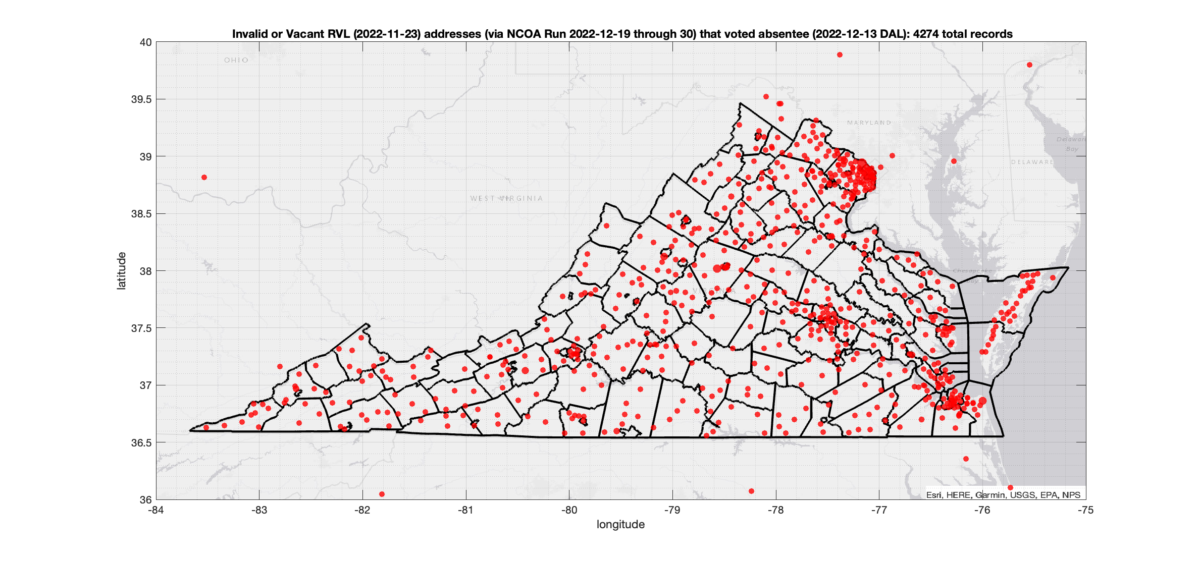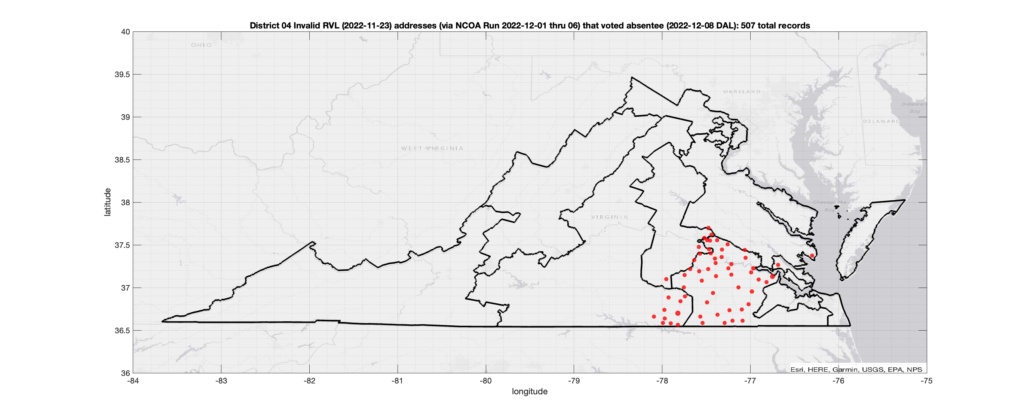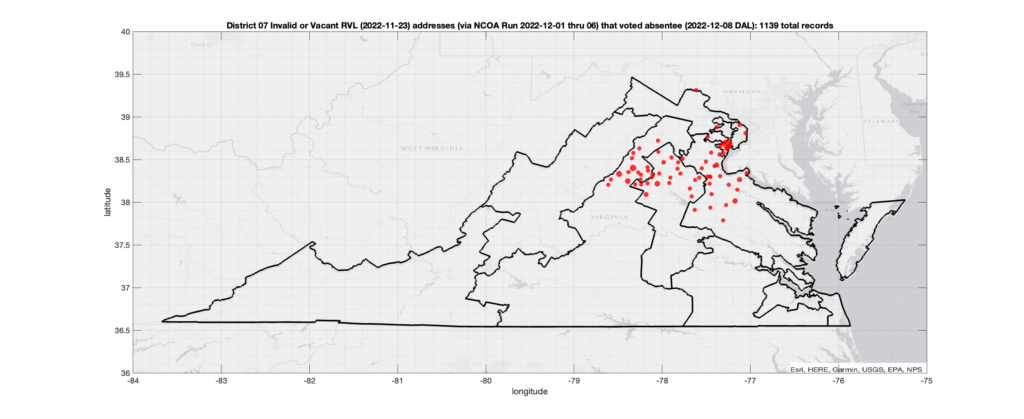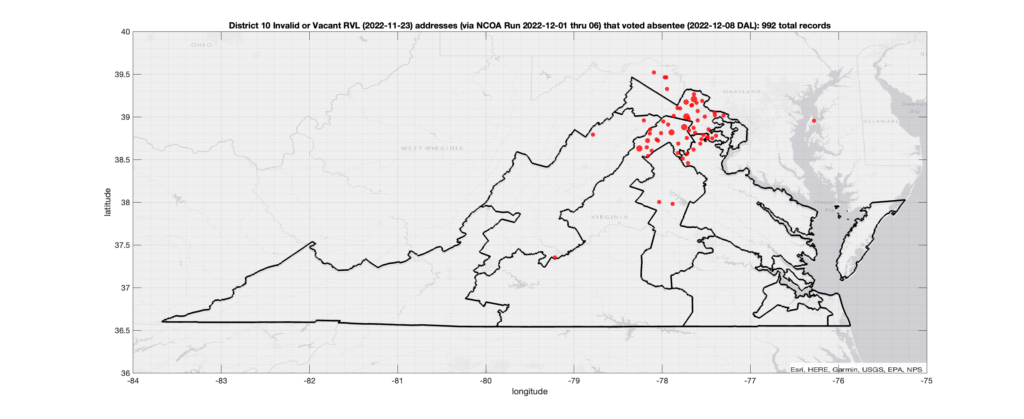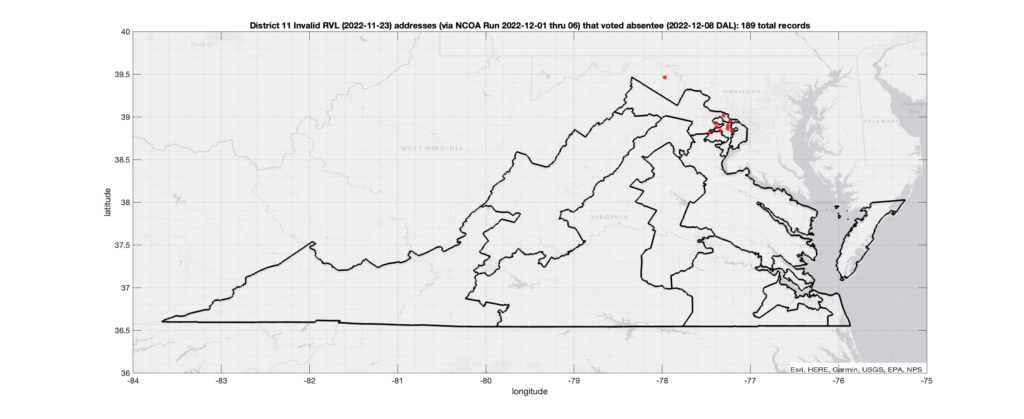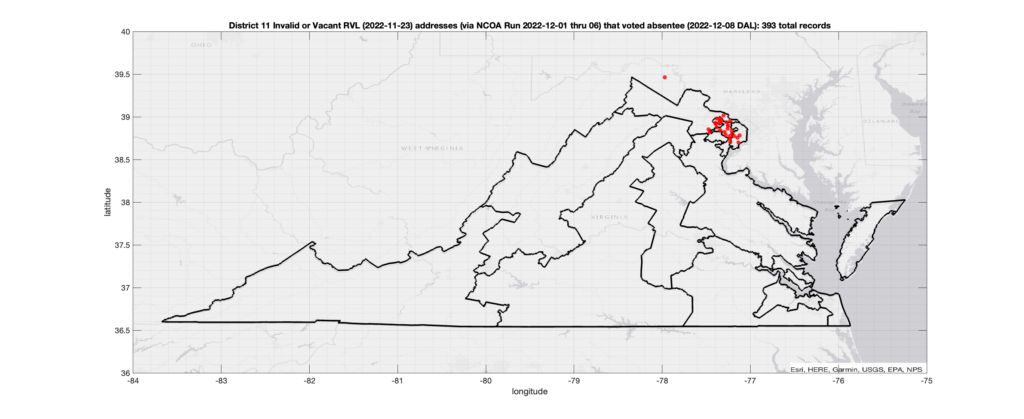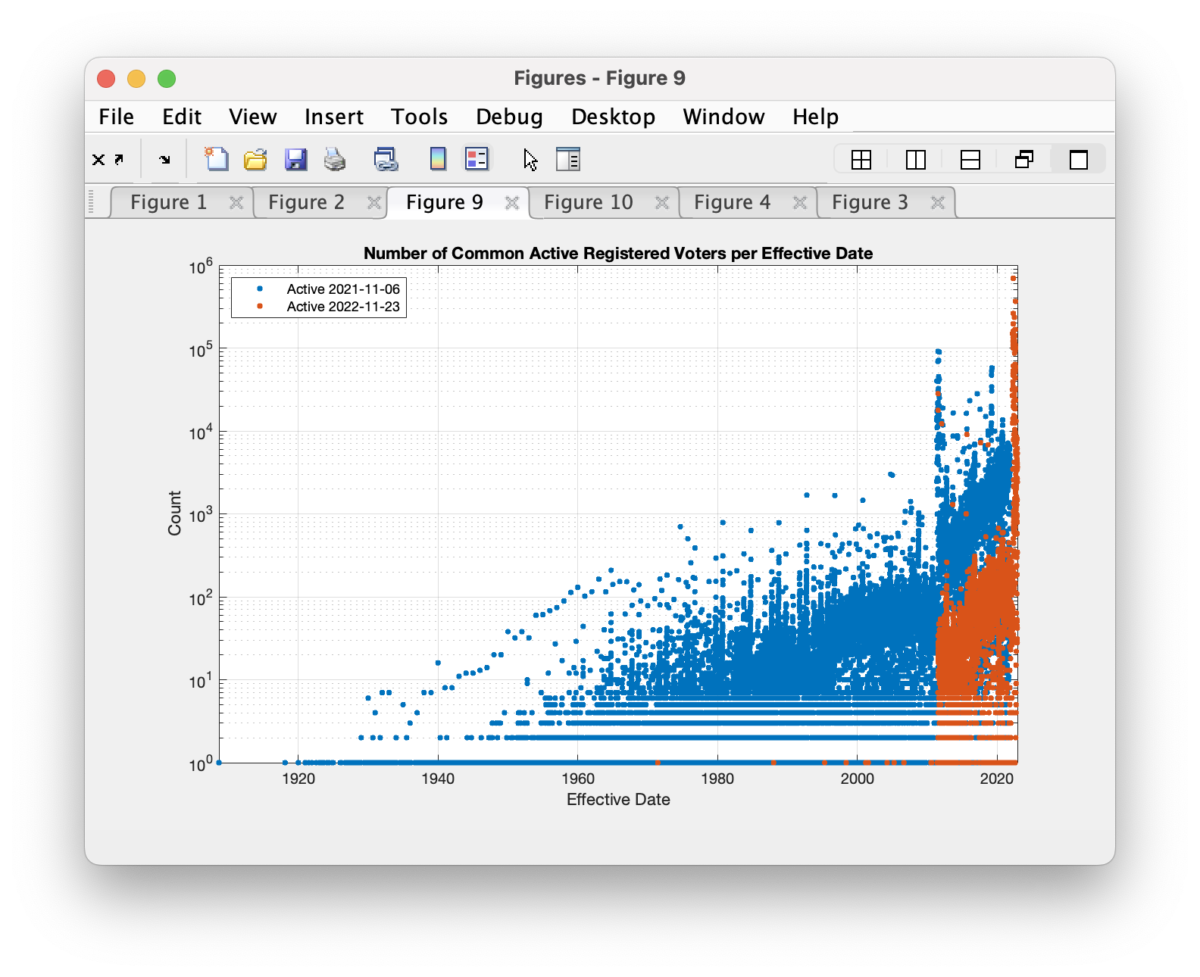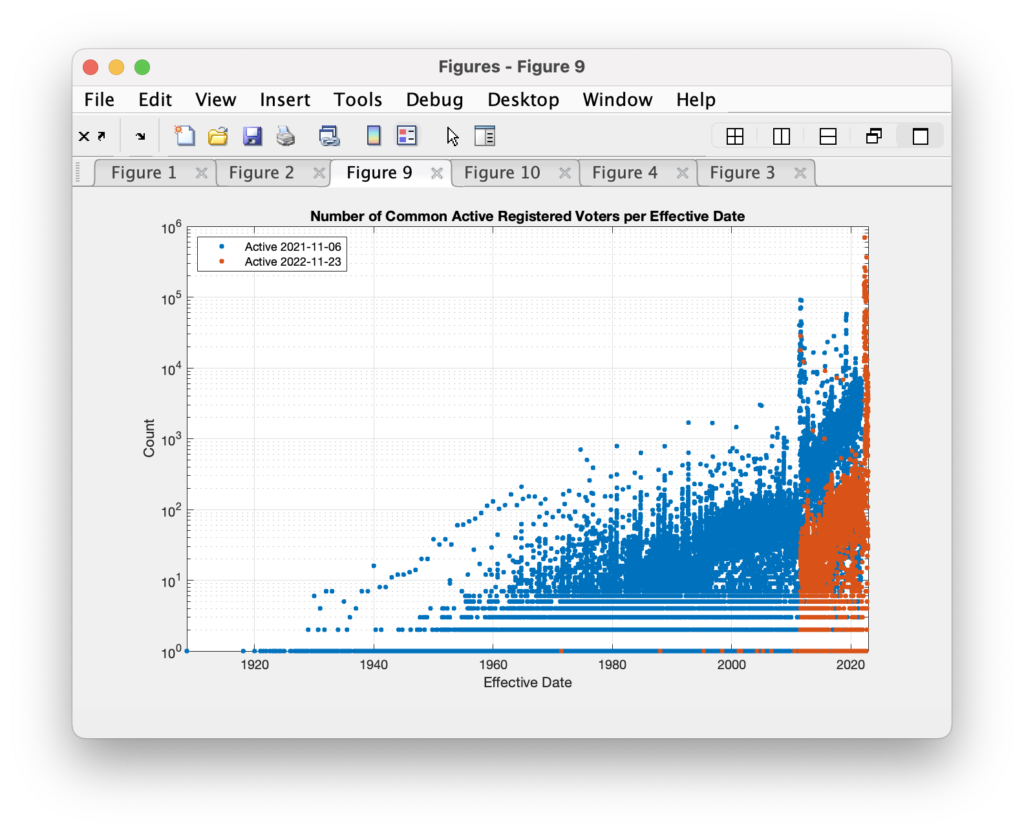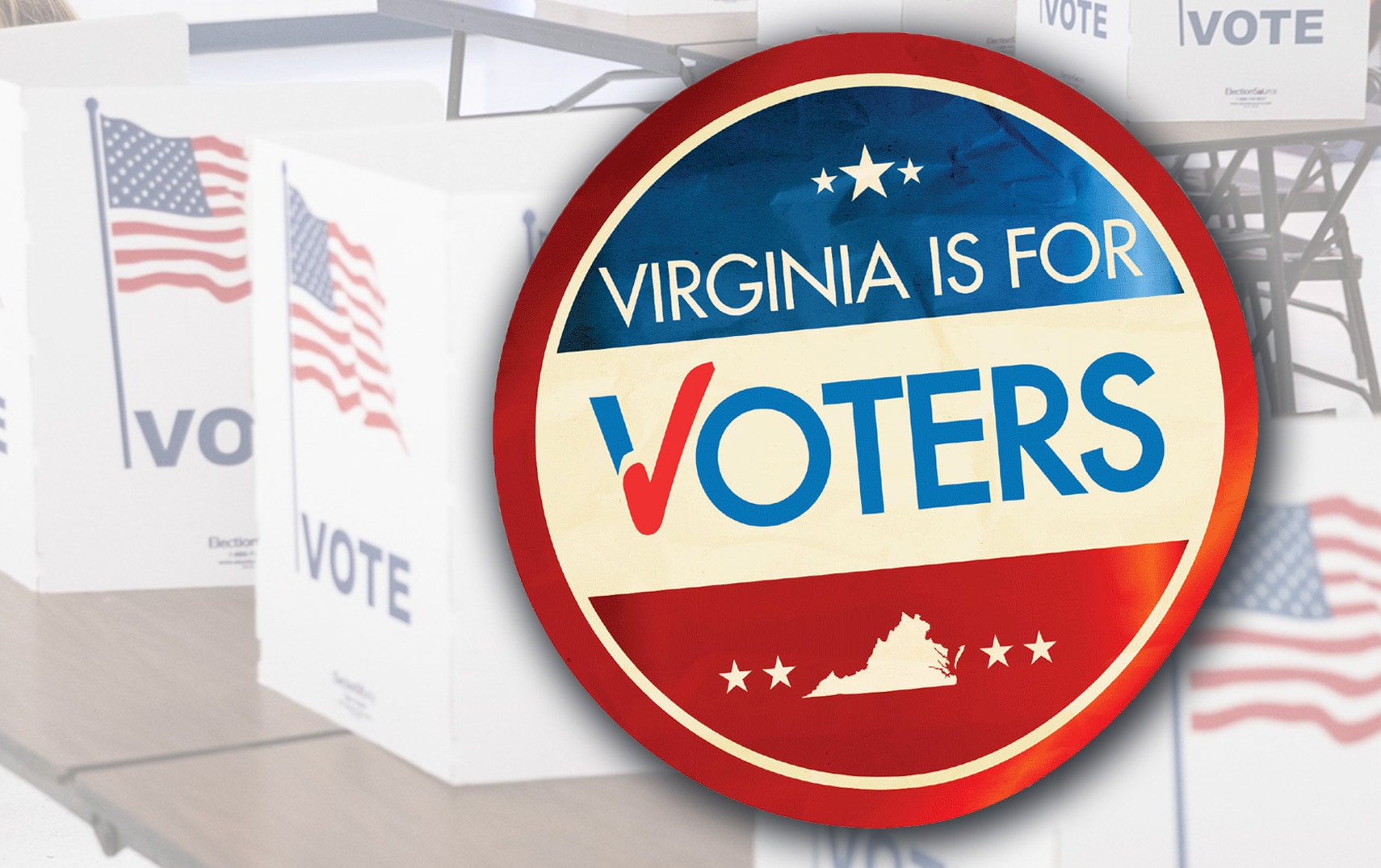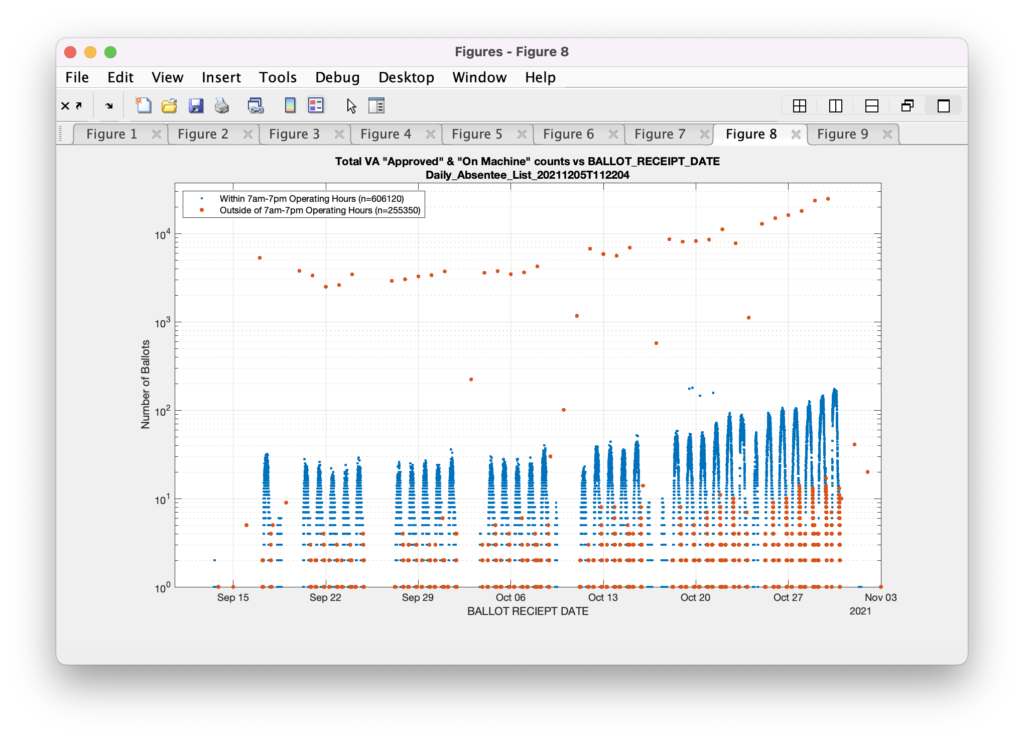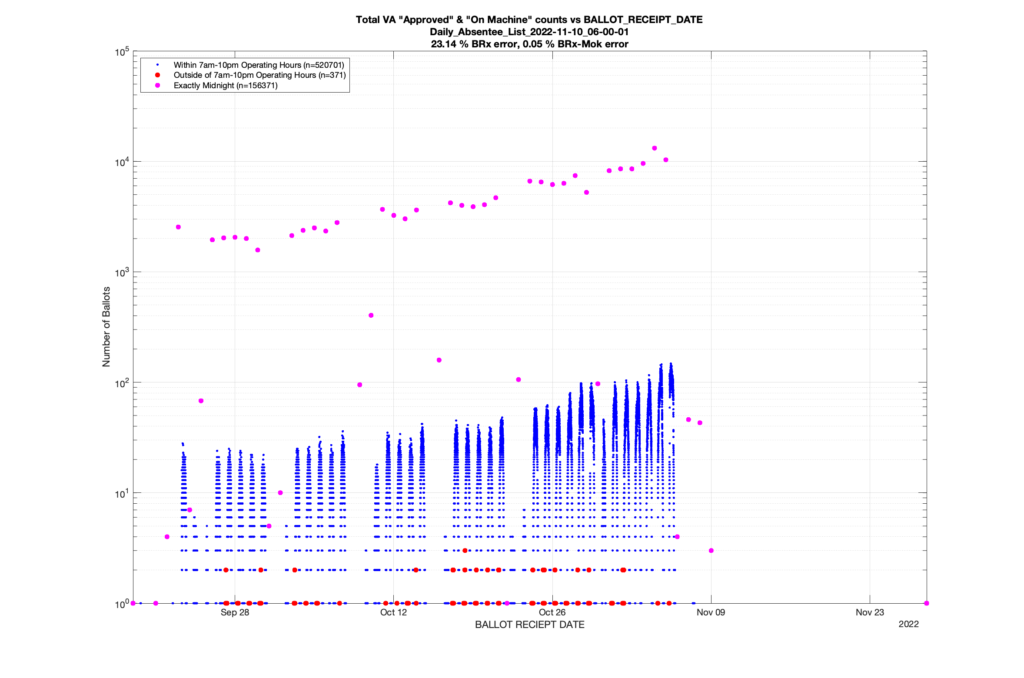Forward:
In a previous post I documented the results from an United States Postal Service (USPS) National Change of Address (NCOA) database check with the 2022 Virginia Registered Voter List (RVL) primary address records joined with the Daily Absentee List (DAL) reports of absentee ballots cast. There was a significant public reaction to the fact that over 15K RVL primary addresses associated with voters who cast ballots in the VA 2022 general election were not recognized by the USPS database as valid addresses (among other issues). I reported the data as I found it, but a common commentary was that my analysis did not account for rural voters who do not have a traditional street address, or that do not have mail receptacles and use PO boxes as their primary delivery mechanism.
The requirements for voter registration and primary address are specified by the VA Constitution, Federal and VA law, and require the following:
- The VA constitution (Section II-1 and II-2) and the National Voter Registration Act (NVRA) requires that registered voter primary addresses be an actual physical (and deliverable) street address. The de-facto arbiter of what defines a recognizable and/or deliverable address is the USPS, therefore a street address that is not recognized or is undeliverable according to USPS is not compliant. We should be making every effort to ensure that the primary address associated with each voter is able to be correctly recognized and translated into a deliverable address by the USPS. This may require adjusting VA’s data normalization policies such that input street addresses are correctly mapped to USPS addresses, or a legislative action in order to correct.
- There is also the legal restriction that registered VA voters are not allowed to use PO Boxes as their primary registered voter address. There is an exception that “protected” voters are allowed to provide a PO box address to be displayed in public records, but their actual address on file must still be a physical address.
- The 2022 VA GREB, section 6..2.3 states that in special cases, a rural voter may supply the name of the highway and enough detail in the comments section of the voter application that the registrar may ascertain where the physical address is. This seems (IMO, but I’m not a lawyer) in contradiction to the language in the VA constitution and in the NVRA that make the implicit requirement of deliverable addresses. Also, if the address as entered is not recognized by the USPS NCOA system, then it will constantly be generating validation errors every time it is checked against the NCOA database, which VA is currently required to do at least annually. Again, this may require adjusting VA’s data normalization policies such that input street addresses are correctly mapped to USPS addresses, or a legislative action in order to correct.
- Additionally the USPS is supposed to recognize “Post Box Street Address” (PBSA) locations such that when someone addresses an envelope or package to the street address of a residence that is served only by delivery to a PO box, the USPS should automatically recognize this and adjust accordingly. Per the NCOA documentation, the USPS NCOA database checks are supposed to be doing this detection and translation already.
And again, to be clear, my point is not to accuse anyone of malicious intent or wrongdoing … I am simply trying to point out that the way we are using and managing our data is discrepant with what the requirements actually are. We either need to change the data and our practices to conform to the legal requirements, or change the law to fit how we are actually (and practically) using the data.
That being said, and in order to show that there are still significant data issues even after adjusting for rural routes, etc., I’ve re-run my NCOA analysis to account for records with invalid primary addresses but that had valid mailing addresses, even if those mailing addresses are PO Boxes. Any RVL record with a primary address that was marked invalid by an NCOA check, but had a different mailing address AND that mailing address was returned from a second NCOA check as NOT-invalid (even if it was a PO Box), was replaced with the mailing address listing and NCOA results. While the requirement is still that primary addresses are supposed to be valid, this re-processing and allowing for primary OR mailing addresses to be used is more in line with the way VA has actually implemented its voter registrations across the state … even though that implementation seems to be at odds with the requirements.
The rest of the analysis is performed the same as before, and is presented in the same format for consistency. I have updated the dates and numerical results as appropriate, but have otherwise kept the format and much of the language and layout the same as the previous analysis.
BLUF (Bottom Line Up Front):
There were 2,164 ballots cast during early voting in the VA 2022 General Election where the voters’ (primary or mailing) registered address on record were flagged as “Invalid” by a National Change of Address (NCOA) database check. If we include addresses that were identified as 90-day Vacant the total rises to 4,274. (The previous analysis that used only the primary addresses returned 15,419 invalid records with associated ballots, and went up to 17,244 when including addresses flagged as vacant.)
A certified commercial provider of NCOA data verification was used to facilitate this analysis on raw data obtained from the VA Dept of Elections (“ELECT”). It is not technically possible to obtain a truly time-synchronized complete set of data for any election due to the way elections are run in VA, but we made every effort to obtain the data from the state as close in time as was possible. The NCOA database is maintained and curated by the United States Postal Service (USPS).
For those wishing to review specific entries, or to help validate these issues, and who are part of an organization that is able to receive and handle election information according to VA law and the VA Dept of Elections requirements, you may contact us to request the raw data breakdowns. We will need to validate your organization or employment and will make data available as legally allowed.
Commentary and Discussion:
I would like to be very clear: We are simply presenting the data as compiled to facilitate public discourse. We have strived to only utilize data directly obtained from authoritative sources (ELECT, the USPS via TrueNCOA provider).
The designation of “Invalid” addresses is according to the definition by the USPS and TrueNCOA, i.e. the TrueNCOA check has reported the addresses as listed in the RVL have no match in the USPS database. Invalid addresses do not include things like valid P.O. Boxes or valid rural addresses that are automatically recognized and translated by USPS to Post Box Street Address (PBSA) records.
The VA Constitution (Section II-1 and II-2) specify the requirements for voter eligibility to include that voters are required to supply a primary address for their registration record, regardless of their method of voting. VA is required by law to consistently maintain and validate these records. Based on the below analysis, the data shows that there is a small but statistically significant number of “Invalid” addresses associated for voters who cast ballots in the Nov 2022 election.
Continuing EPEC’s mission to promote voter participation, analyze election technology, and educate the public about best practices in managing election technology systems; we are providing the below analysis in order to educate and inform the public, legislators and elections officials about the existence of these discrepancies.
Details:
After receiving the results of a National Change of Address (NCOA) database check on the registration (not the temporary) addresses in the latest VA Registered Voter List (RVL). I’ve gone through and collated the flagged addresses and reconciled them with the entries in the Daily Absentee List (DAL) file records provided by the VA Dept. of Elections (“ELECT”).
The DAL file (dated 2022-12-13) provides a records of all of the voters that cast absentee (either Early In-Person or Mail-In) ballots in the election, and the RVL (dated 2022-11-23) gives all of the registered voter addresses and other pertinent information. Both datasets come directly from the VA Dept. of Elections and must be purchased. Total cost was ~$7000. The two datasets can be tied together using the voter Identification Number that is assigned to each (supposedly) unique voter by the state. Entries in the RVL should be unique to each registered voter (although there are a small number of duplicate voter IDs that I have seen … but thats for another post), whereas the DAL file can have multiple entries attributed to a single voter recording the various stages of ballot processing.
The NCOA check was performed on all addresses in the RVL file in order to detect recent moves, invalid addresses, vacant addresses, P.O. Boxes, commercial addresses, etc. The NCOA check takes multiple days to run using a commercial service provider and was executed between 2022-12-19 through 2022-12-30.
*** As noted above, in this run I substituted those primary addresses that evaluated to “invalid” with their corresponding “mailing” address records that had been recognized as “valid”, if possible. ***
Results:
Raw TrueNCOA Processing result stats on the full RVA dataset:
| NCOA Processing of VA RVL Records | Full RVL 11-23 Primary Addresses (12/30/2022) | % | Unique RVL Mailing Addresses (12/30/2022) | % |
| Records Processed | 6,127,856 | 216,896 | ||
| 18 – Month NCOA Moves | 282,669 | 4.61% | 8,247 | 3.80% |
| 48 – Month NCOA Moves | 163,931 | 2.68% | 8,099 | 3.73% |
| Moves with no Forwarding Address | 20,913 | 0.34% | 1,415 | 0.65% |
| Total NCOA Moves | 467,513 | 7.63% | 17,761 | 8.19% |
| Vacant Flag | 29,315 | 0.48% | 22,763 | 10.49% |
| DPV Updated/Address Corrected Records | 601,539 | 9.82% | 18,555 | 8.55% |
| DPV Deliverable Records | 5,835,230 | 95.22% | 165,939 | 76.51% |
| DPV Non-Deliverable Records | 185,752 | 3.03% | 35,100 | 16.18% |
| LACS Updated (Rural Address converted to Street Address) | 33,497 | 0.55% | 254 | 0.12% |
| Residential Delivery Indicator | 5,970,531 | 97.43% | 194,342 | 89.60% |
| Addresses matched to the USPS Database | 6,020,983 | 98.26% | 201,040 | 92.69% |
| Invalid Addresses | 107,304 | 1.75% | 15,968 | 7.36% |
| Expired Addresses | 10,822 | 0.18% | 276 | 0.13% |
| Business Move (B) | 340 | 0.01% | 61 | 0.03% |
| Family Move (F) | 116874 | 1.91% | 5,390 | 2.49% |
| Individual Move (I) | 350299 | 5.72% | 12,310 | 5.68% |
| General Delivery Address | 159 | 0.00% | 170 | 0.08% |
| High Rise Address | 764922 | 12.48% | 7,097 | 3.27% |
| PO Box Address | 28040 | 0.46% | 158,359 | 73.01% |
| Rural Route Address | 81 | 0.00% | 269 | 0.12% |
| Single Family Address | 5243321 | 85.57% | 33,582 | 15.48% |
| Unknown | 51903 | 0.85% | 15,537 | 7.16% |
Combining NCOA results of RVL Addresses with the DAL data:
Vacant Addresses:
There were 2,112 records across the state with addresses that have been flagged as (90-day) “Vacant” by the NCOA check and also had an Early In-Person, Mail-In, FWAB or Provisional ballot cast in the VA 2022 General Election according to the DAL file. Of those records, 1,542 were Early In-Person and 547 were Mail-In. The geographic distribution of the addresses (based on the ZIP+4), as reported by the NCOA service, is shown below, with the size of the marker proportional to the total number of counts at that ZIP+4 location. (Note this is actually an increase over the previous results that were not adjusted for potential mailing address matches.)

P.O. Boxes (Non-protected):
There were 13,492 records across the state with addresses that have been flagged as P.O. Box Addresses by the NCOA check and also had an Early In-Person, Mail-In, FWAB or Provisional ballot cast in the VA 2022 General Election AND were NOT listed as protected entries according to the DAL file. (VA allows for voters who have a legal protective order to list a P.O. Box as their address of record on public documents) Of those records, 11,426 were Early In-Person and 2020 were Mail-In. The geographic distribution of the addresses (based on the ZIP+4), as reported by the NCOA service, is shown below, with the size of the marker proportional to the total number of counts at that ZIP+4 location.
Note, this is actually an increase over the previous results that were not adjusted for potential mailing address matches. This is not unexpected, as there are a number of PO box mailing addresses that have been substituted in for invalid primary street addresses. PO Boxes are not supposed to be allowed as registered voting addresses. (You should talk to your legislators about this discrepancy, because this catch-22 will likely need to be changed by legislative action!)

Invalid Addresses:
There were 2,164 records across the state with addresses that have been flagged as “Invalid” Addresses by the NCOA check and also had an Early In-Person, Mail-In, FWAB or Provisional ballot cast in the VA 2022 General Election. Of those records, 1,535 were Early In-Person and 598 were Mail-In. The geographic distribution of the addresses (based on the ZIP+4), as reported by the NCOA service, is shown below, with the size of the marker proportional to the total number of counts at that ZIP+4 location. Note, this is actually a significant decrease over the previous results that were not adjusted for potential mailing addresses. This is not unexpected, as there were a number of invalid primary address with a valid (even if PO Box) mailing address. (The fact that the primary addresses do not validate with the USPS is it’s own issue, but we are ignoring that for this analysis as noted above.)

Invalid OR Vacant Addresses:
There were 4,274 records across the state with addresses that have been flagged as “Invalid” or “Vacant” Addresses by the NCOA check and also had an Early In-Person, Mail-In, FWAB or Provisional ballot cast in the VA 2022 General Election. Of those records, 3,077 were Early In-Person and 1,143 were Mail-In. The geographic distribution of the addresses (based on the ZIP+4), as reported by the NCOA service, is shown below, with the size of the marker proportional to the total number of counts at that ZIP+4 location.
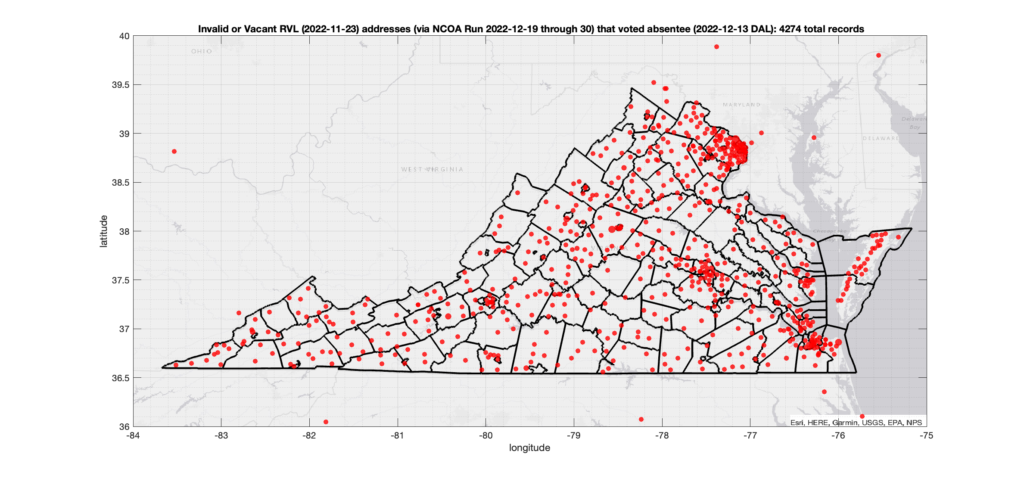
Record of Moves Out-of-State:
There were 797 records that had records of NCOA moves to valid out-of-state addresses before 2022-08 that also had an Early In-Person, Mail-In, FWAB or Provisional ballot cast in the VA 2022 General Election. Of those records, 346 were Early In-Person and 450 were Mail-In. The geographic distribution of the addresses (based on the ZIP+4), as reported by the NCOA service, is shown below, with the size of the marker proportional to the total number of counts at that ZIP+4 location.

Results By District:
District 01:
Invalid Addresses:
There were 213 records with registered addresses that have been flagged as “Invalid” Addresses by the NCOA check and also had an Early In-Person, Mail-In, FWAB or Provisional ballot cast in the VA 2022 General Election in District 01. Of those records, 170 were Early In-Person and 38 were Mail-In. The geographic distribution of the addresses (based on the ZIP+4), as reported by the NCOA service, is shown below, with the size of the marker proportional to the total number of counts at that ZIP+4 location.

Invalid OR Vacant Addresses:
There were 364 records with registered addresses that have been flagged as “Invalid” or “Vacant” Addresses by the NCOA check and also had an Early In-Person, Mail-In, FWAB or Provisional ballot cast in the VA 2022 General Election in District 01. Of those records, 288 were Early In-Person and 71 were Mail-In. The geographic distribution of the addresses (based on the ZIP+4), as reported by the NCOA service, is shown below, with the size of the marker proportional to the total number of counts at that ZIP+4 location.
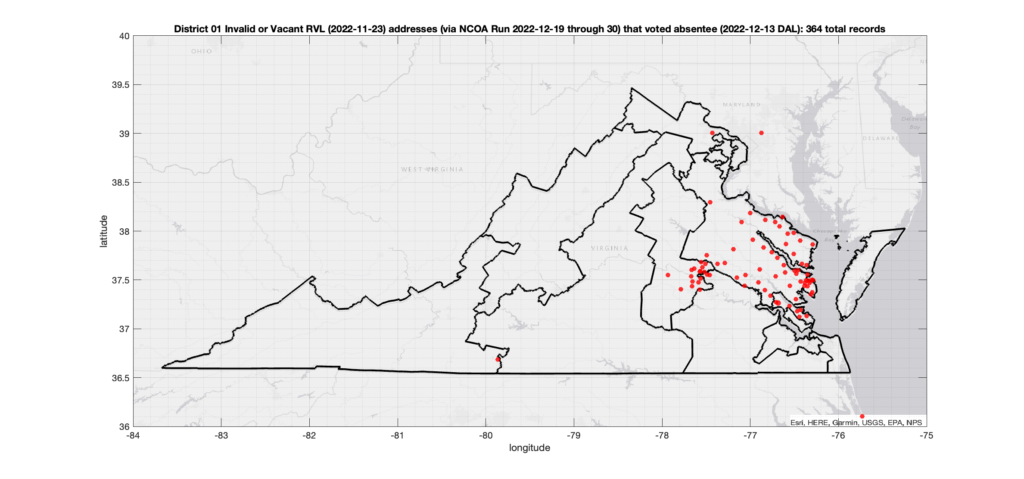
District 02:
Invalid Addresses:
There were 183 records with registered addresses that have been flagged as “Invalid” Addresses by the NCOA check and also had an Early In-Person, Mail-In, FWAB or Provisional ballot cast in the VA 2022 General Election in District 02. Of those records, 147 were Early In-Person and 33 were Mail-In. The geographic distribution of the addresses (based on the ZIP+4), as reported by the NCOA service, is shown below, with the size of the marker proportional to the total number of counts at that ZIP+4 location.

Invalid OR Vacant Addresses:
There were 441 records with registered addresses that have been flagged as “Invalid” or “Vacant” Addresses by the NCOA check and also had an Early In-Person, Mail-In, FWAB or Provisional ballot cast in the VA 2022 General Election in District 02. Of those records, 344 were Early In-Person and 90 were Mail-In. The geographic distribution of the addresses (based on the ZIP+4), as reported by the NCOA service, is shown below, with the size of the marker proportional to the total number of counts at that ZIP+4 location.

District 03:
Invalid Addresses:
There were 37 records with registered addresses that have been flagged as “Invalid” Addresses by the NCOA check and also had an Early In-Person, Mail-In, FWAB or Provisional ballot cast in the VA 2022 General Election in District 03. Of those records, 27 were Early In-Person and 10 were Mail-In. The geographic distribution of the addresses (based on the ZIP+4), as reported by the NCOA service, is shown below, with the size of the marker proportional to the total number of counts at that ZIP+4 location.

Invalid OR Vacant Addresses:
There were 324 records with registered addresses that have been flagged as “Invalid” or “Vacant” Addresses by the NCOA check and also had an Early In-Person, Mail-In, FWAB or Provisional ballot cast in the VA 2022 General Election in District 03. Of those records, 223 were Early In-Person and 94 were Mail-In. The geographic distribution of the addresses (based on the ZIP+4), as reported by the NCOA service, is shown below, with the size of the marker proportional to the total number of counts at that ZIP+4 location.

District 04:
Invalid Addresses:
There were 116 records with registered addresses that have been flagged as “Invalid” Addresses by the NCOA check and also had an Early In-Person, Mail-In, FWAB or Provisional ballot cast in the VA 2022 General Election in District 04. Of those records, 104 were Early In-Person and 12 were Mail-In. The geographic distribution of the addresses (based on the ZIP+4), as reported by the NCOA service, is shown below, with the size of the marker proportional to the total number of counts at that ZIP+4 location.

Invalid OR Vacant Addresses:
There were 318 records with registered addresses that have been flagged as “Invalid” or “Vacant” Addresses by the NCOA check and also had an Early In-Person, Mail-In, FWAB or Provisional ballot cast in the VA 2022 General Election in District 04. Of those records, 256 were Early In-Person and 59 were Mail-In. The geographic distribution of the addresses (based on the ZIP+4), as reported by the NCOA service, is shown below, with the size of the marker proportional to the total number of counts at that ZIP+4 location.

District 05:
Invalid Addresses:
There were 383 records with registered addresses that have been flagged as “Invalid” Addresses by the NCOA check and also had an Early In-Person, Mail-In, FWAB or Provisional ballot cast in the VA 2022 General Election in District 05. Of those records, 299 were Early In-Person and 81 were Mail-In. The geographic distribution of the addresses (based on the ZIP+4), as reported by the NCOA service, is shown below, with the size of the marker proportional to the total number of counts at that ZIP+4 location.

Invalid OR Vacant Addresses:
There were 584 records with registered addresses that have been flagged as “Invalid” or “Vacant” Addresses by the NCOA check and also had an Early In-Person, Mail-In, FWAB or Provisional ballot cast in the VA 2022 General Election in District 05. Of those records, 445 were Early In-Person and 134 were Mail-In. The geographic distribution of the addresses (based on the ZIP+4), as reported by the NCOA service, is shown below, with the size of the marker proportional to the total number of counts at that ZIP+4 location.

District 06:
Invalid Addresses:
There were 202 records with registered addresses that have been flagged as “Invalid” Addresses by the NCOA check and also had an Early In-Person, Mail-In, FWAB or Provisional ballot cast in the VA 2022 General Election in District 06. Of those records, 144 were Early In-Person and 53 were Mail-In. The geographic distribution of the addresses (based on the ZIP+4), as reported by the NCOA service, is shown below, with the size of the marker proportional to the total number of counts at that ZIP+4 location.

Invalid OR Vacant Addresses:
There were 400 records with registered addresses that have been flagged as “Invalid” or “Vacant” Addresses by the NCOA check and also had an Early In-Person, Mail-In, FWAB or Provisional ballot cast in the VA 2022 General Election in District 06. Of those records, 301 were Early In-Person and 91 were Mail-In. The geographic distribution of the addresses (based on the ZIP+4), as reported by the NCOA service, is shown below, with the size of the marker proportional to the total number of counts at that ZIP+4 location.

District 07:
Invalid Addresses:
There were 243 records with registered addresses that have been flagged as “Invalid” Addresses by the NCOA check and also had an Early In-Person, Mail-In, FWAB or Provisional ballot cast in the VA 2022 General Election in District 07. Of those records, 169 were Early In-Person and 68 were Mail-In. The geographic distribution of the addresses (based on the ZIP+4), as reported by the NCOA service, is shown below, with the size of the marker proportional to the total number of counts at that ZIP+4 location.
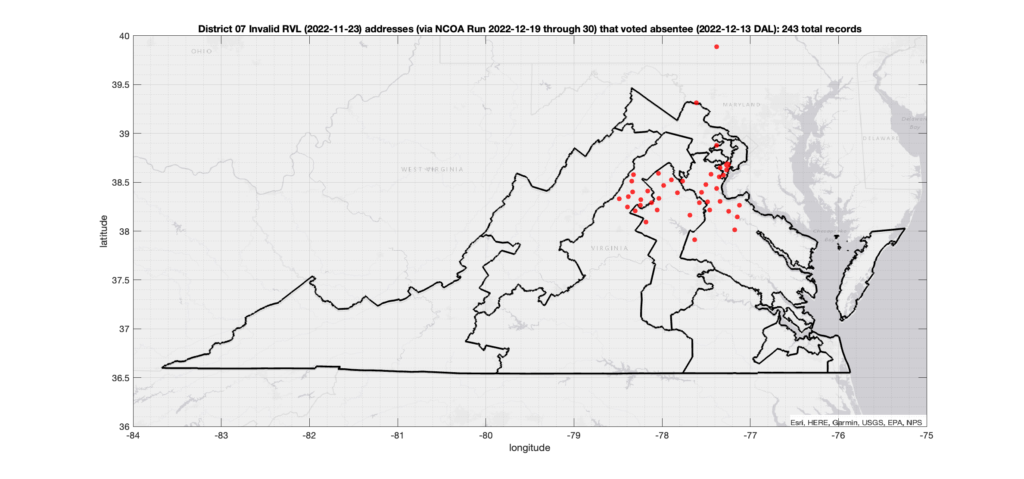
Invalid OR Vacant Addresses:
There were 370 records with registered addresses that have been flagged as “Invalid” or “Vacant” Addresses by the NCOA check and also had an Early In-Person, Mail-In, FWAB or Provisional ballot cast in the VA 2022 General Election in District 07. Of those records, 274 were Early In-Person and 87 were Mail-In. The geographic distribution of the addresses (based on the ZIP+4), as reported by the NCOA service, is shown below, with the size of the marker proportional to the total number of counts at that ZIP+4 location.
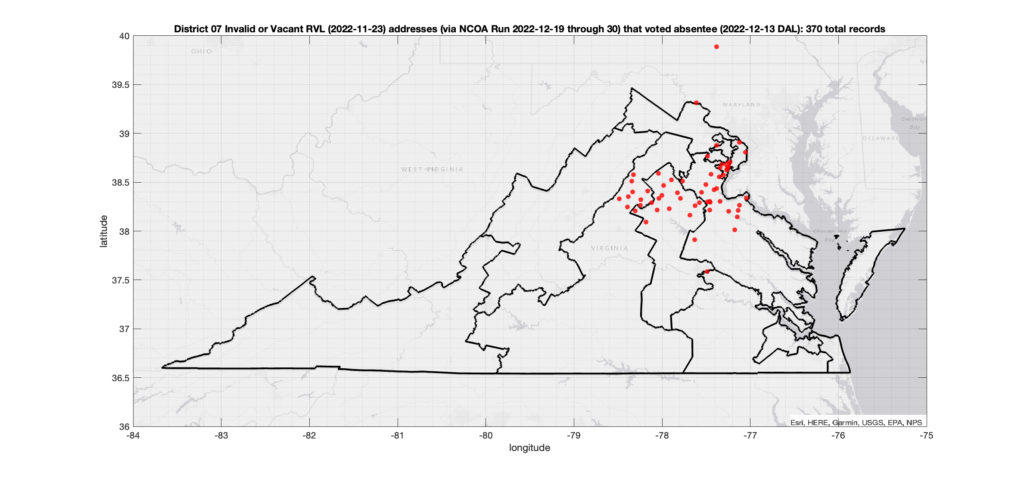
District 08:
Invalid Addresses:
There were 165 records with registered addresses that have been flagged as “Invalid” Addresses by the NCOA check and also had an Early In-Person, Mail-In, FWAB or Provisional ballot cast in the VA 2022 General Election in District 08. Of those records, 69 were Early In-Person and 94 were Mail-In. The geographic distribution of the addresses (based on the ZIP+4), as reported by the NCOA service, is shown below, with the size of the marker proportional to the total number of counts at that ZIP+4 location.

Invalid OR Vacant Addresses:
There were 413 records with registered addresses that have been flagged as “Invalid” or “Vacant” Addresses by the NCOA check and also had an Early In-Person, Mail-In, FWAB or Provisional ballot cast in the VA 2022 General Election in District 08. Of those records, 226 were Early In-Person and 183 were Mail-In. The geographic distribution of the addresses (based on the ZIP+4), as reported by the NCOA service, is shown below, with the size of the marker proportional to the total number of counts at that ZIP+4 location.

District 09:
Invalid Addresses:
There were 328 records with registered addresses that have been flagged as “Invalid” Addresses by the NCOA check and also had an Early In-Person, Mail-In, FWAB or Provisional ballot cast in the VA 2022 General Election in District 09. Of those records, 257 were Early In-Person and 66 were Mail-In. The geographic distribution of the addresses (based on the ZIP+4), as reported by the NCOA service, is shown below, with the size of the marker proportional to the total number of counts at that ZIP+4 location.

Invalid OR Vacant Addresses:
There were 479 records with registered addresses that have been flagged as “Invalid” or “Vacant” Addresses by the NCOA check and also had an Early In-Person, Mail-In, FWAB or Provisional ballot cast in the VA 2022 General Election in District 09. Of those records, 373 were Early In-Person and 100 were Mail-In. The geographic distribution of the addresses (based on the ZIP+4), as reported by the NCOA service, is shown below, with the size of the marker proportional to the total number of counts at that ZIP+4 location.

District 10:
Invalid Addresses:
There were 174 records with registered addresses that have been flagged as “Invalid” Addresses by the NCOA check and also had an Early In-Person, Mail-In, FWAB or Provisional ballot cast in the VA 2022 General Election in District 10. Of those records, 104 were Early In-Person and 68 were Mail-In. The geographic distribution of the addresses (based on the ZIP+4), as reported by the NCOA service, is shown below, with the size of the marker proportional to the total number of counts at that ZIP+4 location.

Invalid OR Vacant Addresses:
There were 246 records with registered addresses that have been flagged as “Invalid” or “Vacant” Addresses by the NCOA check and also had an Early In-Person, Mail-In, FWAB or Provisional ballot cast in the VA 2022 General Election in District 10. Of those records, 164 were Early In-Person and 82 were Mail-In. The geographic distribution of the addresses (based on the ZIP+4), as reported by the NCOA service, is shown below, with the size of the marker proportional to the total number of counts at that ZIP+4 location.

District 11:
Invalid Addresses:
There were 122 records with registered addresses that have been flagged as “Invalid” Addresses by the NCOA check and also had an Early In-Person, Mail-In, FWAB or Provisional ballot cast in the VA 2022 General Election in District 11. Of those records, 46 were Early In-Person and 75 were Mail-In. The geographic distribution of the addresses (based on the ZIP+4), as reported by the NCOA service, is shown below, with the size of the marker proportional to the total number of counts at that ZIP+4 location.

Invalid OR Vacant Addresses:
There were 335 records with registered addresses that have been flagged as “Invalid” or “Vacant” Addresses by the NCOA check and also had an Early In-Person, Mail-In, FWAB or Provisional ballot cast in the VA 2022 General Election in District 11. Of those records, 181 were Early In-Person and 152 were Mail-In. The geographic distribution of the addresses (based on the ZIP+4), as reported by the NCOA service, is shown below, with the size of the marker proportional to the total number of counts at that ZIP+4 location.

Summary Data Files by Locality:
The complete set of graphics and statistics for each locality, and each congressional district in VA can be downloaded here as a zip file. The tabulated summary results can also be downloaded in excel, csv, or numbers format:
